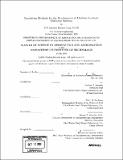Simulation methods for the development of modular strategic guidance systems
Author(s)
Long, Stephen Michael, Ensign
DownloadFull printable version (6.028Mb)
Other Contributors
Massachusetts Institute of Technology. Dept. of Aeronautics and Astronautics.
Advisor
Andrew J. Staugler and Peter M. Kachmar.
Terms of use
Metadata
Show full item recordAbstract
The traditional approach to simulation-based system design results in a stovepiped development process where subsystems are developed independently and integration requirements are then levied on the system architecture. For applications like the MK6 Life Extension program, where a modular system architecture is the primary design goal, this method of simulation-based design is inadequate. Sponsored by the System Engineering System Design and Analysis Group at the Draper Laboratory, this thesis proposes an alternate top-down approach to simulation-based design, where the system architecture is established first, and the system is developed in an integrated fashion. Through this approach, the modularity requirements are then levied on the subsystems according to the integrated system architecture. In this thesis, a system-level simulation concept is developed via this approach to facilitate analysis of key guidance system design issues and evaluation of integrated system requirements. The simulation concept, which utilizes existing modeling and simulation tools, is validated through the design of a candidate guidance system and its usefulness is illustrated via selected guidance system modularity studies.
Description
Thesis (S.M.)--Massachusetts Institute of Technology, Dept. of Aeronautics and Astronautics, 2003. Cataloged from PDF version of thesis. Includes bibliographical references (p. 109).
Date issued
2003Department
Massachusetts Institute of Technology. Department of Aeronautics and AstronauticsPublisher
Massachusetts Institute of Technology
Keywords
Aeronautics and Astronautics.